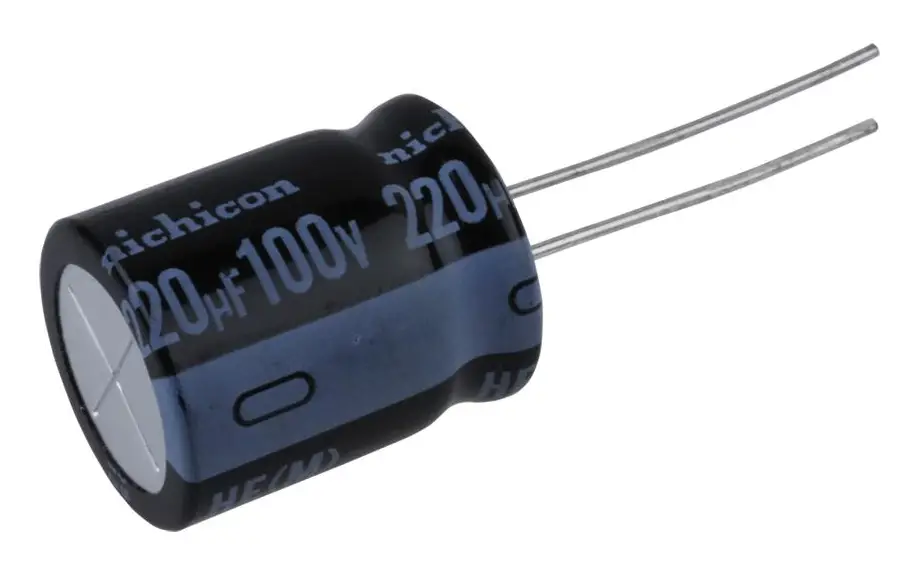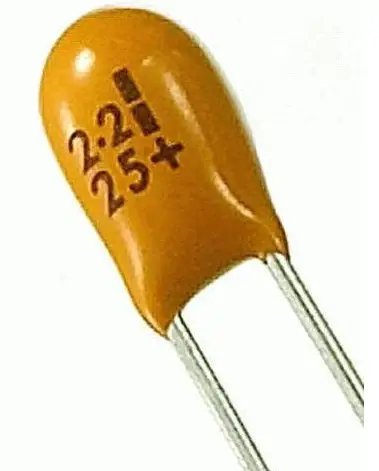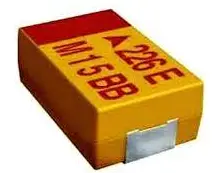An electrolytic capacitor has an electrolyte as its dielectric medium. It has a larger capacitance than other capacitor types. Electrolytic capacitors are suitable for storing a large amount of energy at low frequencies.
In the electrical and electronics world, capacitors are widely used to store and release energy. They are also used to maintain or regulate the voltage level to achieve maximum efficiency. They are being used in numerous applications at the current time.
What is an Electrolytic Capacitor?
We can define an electrolytic capacitor as a “specific polarized nature capacitor that utilizes an electrolyte material as its dielectric material”. Their polarized behavior indicates that they have positive and negative plates/terminals to perform their function. Moreover, the positive terminal/plate voltages are higher as compared to the negative plate/terminal. The electrolyte material enables the electrolytic capacitor to produce large capacitances.
The electrolyte used in these capacitors is a liquid or gel-like substance that works as a dielectric material. It enables the electrolytic capacitor to have a large capacitance in its compact size. This electrolyte is conductive in nature due to its salt solution that can allow passage of current through them. One common electrolyte used in these capacitors is boric acid or ammonium borate in water. These capacitors are utilized for various purposes especially to store large charges.
Construction of Electrolytic Capacitor
Electrolytic capacitors are generally made up of aluminum or tantalum material. For anode construction, we use a thin aluminum foil that is slightly roughened to increase the surface area. Now the increased surface will help to achieve to get large capacitance. Anode acts as the positive terminal of the capacitor.
The dielectric material in an electrolytic capacitor is made up of an oxide layer present on the anode layer. This oxide layer behaves as an insulating material between the anode and cathode. Normally, the dielectric forms when we apply voltage at the anode in the presence of an electrolyte.
The electrolyte is a conductive solution in an electrolytic capacitor that contacts the anode and cathode. It has ions that enable the flow of current in an electrolytic capacitor. It has a plus point that in case of any damage, it reproduces an oxide layer on the anode. You can see the construction in the following image.

The cathode is typically a carbon-based layer that is coated on the dielectric layer. This layer in the electrolytic capacitor behaves as the second conductive layer. It is connected to the negative terminal of the capacitor.
Other components are also present in the construction of the electrolytic capacitor:
- Separator: To avoid contact between anode and cathode.
- Enclosure: Entire assembly is covered/enclosed in a suitable cover.
Types of Electrolytic Capacitors
There are different types the electrolytic capacitors depending on their characteristics and applications. Here are the major types:
- Aluminum Electrolytic Capacitor: This is the common type of electrolytic capacitor and this type has large capacitance. For its construction, it is available in both radial and axial configurations. These circuits are commonly used in power supply circuits and those application that desire higher capacitances. They are available in polarized and non-polarized configurations. They are available in up to 2000 volts ratings in the capacitor ranges from 1mF to 47000 mF.

- Tantalum Electrolytic Capacitor: These capacitors are highly efficient in their operation. They have both solid and wet electrolytes. Tantalum capacitors are commonly used in portable electronic devices. They are available in up to 50 volts ratings in the capacitor ranges from 47 nF to 470 microfarads.

- Niobium Electrolytic Capacitor: The anode of this capacitor is made up of niobium monoxide. This type is similar to tantalum capacitors. But they are available at a lesser cost. Tantalum capacitors are commonly used in computer applications and electronic devices.

All types are present with their plus points and can help the consumer with their respective applications.
Symbol of Electrolytic Capacitor
Here is the symbol for an electrolytic capacitor. It contains a “+” sign for the positive or anode layer. Similarly, it can contain a “-” sign or we can interpret from the anode the other side is a negative layer called the cathode. This is the standard symbol of the electrolytic capacitors.

The curved lines on the top side represent the anode which is a positive terminal, and the straight line at the bottom side represents the cathode which is a negative terminal. Its polarity is important. We need to keep it to perform the function without any disturbance. These symbols may vary depending on the type slightly but the “+”, and “-” signs for polarity will remain the same.
Capacitor Characteristics
Capacitance Tolerance
The electrolytic capacitor’s capacitance has large tolerance and shows drift in capacitance value from its nominal value as time passes. The typical tolerance of the electrolytic capacitor is 20 % of the nominal value. For example, an aluminum capacitor of 100 µF may have a capacitance value between 80 to 120 µF. The capacitance tolerance is the percentage of allowed deviation of measured capacitance from the rated value. These capacitors are available in a variety of tolerance series given below.
| Rated Capacitance | Tolerance | Series | Letter Code |
| ±20% | E3 | M | |
| ±20% | E6 | M | |
| ±10% | E12 | K |
The maximum voltage rating of the tantalum capacitors is low, therefore tantalum capacitors can not be used in place of an aluminum capacitor.
Working Temperature
The working temperature of the capacitor should be below 85oC. The aluminum electrolytic capacitor if operated above 85oC can cause evaporation of electrolytes and this further may lead to deformation of the capacitor’s body due to internal pressure. Also, electrolytic jelly freezes at -10oC , therefore capacitors can not be used at low temperatures.
Advantages of Electrolytic Capacitors
The followings are the key advantages.
- Higher Capacitances: They are capable to achieve larger capacitances. So they can be used for applications that require large capacitances. This large capacitance allows the smoothing, voltage regulations, and filtering of power supplies in a circuit.
- Compact size: They can provide small physical size with large capacitances. This is another plus point of the electrolytic capacitors.
- Cost Effective: These capacitors are available at a lesser cost.
- Higher Voltage Ratings: These capacitors are available with large voltage ratings. It indicates that they can handle large. With this advantage, they help in power factor correction in the power system.
- Polarized Capacitances: This property helps in those circuits which require rectified or controlled flow of current in an electric circuit. They help in AC and DC circuits where the voltage direction is important.
Limitations
Here are some limitations of the electrolytic capacitor:
- Offering higher leakage currents value
- Temperature Sensitivity
- Higher equivalent series resistance (ESR)
- Lesser lifetime
- In certain cases, they have reliability concerns
Applications of Electrolytic Capacitors
There are different electrolytic capacitors used in different applications. Applications of these capacitors are listed below.
- Power Supply Filtering: These capacitors filter the output voltage to remove noise and smooth the output voltage.
- Higher Charge Storing: Due to their large capacitances, they can store large charges.
- Filter: They can be used as low-pass filters in case of a weak DC signal with a small AC component. But they are only workable with small magnitudes and small frequencies.
- Power Converter: These capacitors are used for smoothening of rectified DC in AC to DC converters.
- LED Lighting: These capacitors are used in LED lighting applications for power supply circuits and driver circuits.
- Flash Lights- These capacitors store a large amount of power for use in flashlights.
Conclusion
Electrolytic capacitors are being utilized in tons of applications at the current time. There are different types the electrolytic capacitors depending on their applications. The electrolyte material in these capacitors enables them to produce large capacitances.